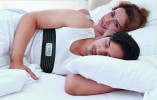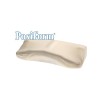Do you suffer from sleep apnea and are looking for effective solutions to treat it? We present various techniques that can help you overcome this sleep disorder. These solutions include both medical and natural techniques. We'd like to remind you that sleep apnea is a potentially serious disorder, and it's important to consult a doctor or healthcare professional for a diagnosis before making any decisions.
Natural solutions to help treat sleep apnea
Sleep apnea is a disorder that mainly affects adults, and is characterized by pauses in breathing during sleep. Symptoms can range from moderate to severe sleep disturbances, and it's important to seek early treatment to prevent complications. There are several natural solutions to prevent or help treat sleep apnea.
- Losing weight - Significant weight loss can reduce pressure on the neck and improve breathing during sleep.
- Stop smoking - Smoking can cause inflammation of the airways and thicken the throat, leading to breathing difficulties.
- Reduce alcohol consumption - Excessive alcohol consumption can cause throat muscles to relax, worsening sleep apnea symptoms.
- Stretching exercises - Specific exercises can strengthen throat muscles and help maintain continuous breathing during sleep.
- Postural changes - Sleeping on your back or side can reduce the risk of sleep apnea.
Adopting a healthy lifestyle with a balanced diet rich in fruits, vegetables and whole grains is recommended to maintain overall good health.
Common medical treatments for sleep apnea
The medical treatments used forsleep apnea are specific to each patient. However, the most common treatment is a breathing machine, called a CPAP, which keeps the airways open. The mask and tubing are connected to the machine and provide a flow of air to the person while they sleep. Another type of medical treatment is mandibular advancement. This procedure moves the lower jaw forward to open the airway and improve night-time breathing. Other treatments include lifestyle changes and surgery to remove tissue or parts of the soft palate blocking the upper airway.
Treatment of sleep apnea with mandibular advancement orthoses
When you suffer from sleep apnea, treatment generally involves the use of oral appliances. These devices are designed to help reduce or eliminate symptoms by maintaining proper breathing during sleep. The most commonly used solution is the mandibular advancement appliance or mandibular advancement orthosis.
This appliance generally consists of two mouthpieces: one part that fits over the upper jaw, and another part that fits over the lower jaw and moves it forward. When you wear this device while you sleep, it helps improve airflow by keeping the airways open. This enables deeper, less disturbed breathing throughout the night. This device is particularly effective in cases ofobstructive apnea.
Treatment of sleep apnea with continuous positive airway pressure (CPAP)
Sleep apnea is a serious respiratory disorder that can be successfully treated with Continuous Positive Airway Pressure (CPAP). CPAP is an effective first-line treatment for sleep apnea sufferers. It involves maintaining positive pressure in the airways to prevent them from closing during sleep. CPAP can be incredibly effective in reducing snoring and sleep apnea. In this way, it helps to improve patients' quality of life.
This treatment is performed using a mask connected to a CPAP device, which delivers a constant, continuous pressure to the airways. In practice, the device is small, relatively silent and placed beside the bed. In most cases, a healthcare professional is on hand to teach the patient how to use the device properly, and to observe the rules of hygiene.
Although this treatment may seem restrictive and have side effects such as irritation, it offers excellent results for cases of severe sleep apnea. Continuous positive airway pressure (CPAP) is almost always effective (in 80-100% of cases).
Regular follow-up treatment is essential to minimize the impact of apnea on quality of life and health. A single night without treatment can lead to the reappearance of daytime sleepiness.
Treatment is recommended if the apnea-hypopnea index (AHI) is high (greater than or equal to 30), or if it is between 15 and 30 with frequent micro-awakenings per hour of sleep, or in the presence of associated severe cardiovascular disease.
The treatment is reimbursable by the Assurance Maladie and requires a prior request from the prescribing physician. It must be used for at least 2 hours a night, and efficacy must be demonstrated to qualify for reimbursement.
Other promising treatment methods for sleep apnea
Sleep apnea is a serious disorder. Although the most common treatment involves wearing one of the breathing devices mentioned above, a variety of other methods are also available and offer promising results.
Body positioning
Body positioning is a non-invasive method that can be used to relieve sleep apnea. When you sleep, you should try to position yourself on your side rather than your back to help reduce the risk of airway obstruction. Products such as the electronic belt which can correct your posture and encourage lateral positioning, or pillows have proven their worth in the treatment of positional apnea. Positional therapy can also help reduce the severity of symptoms.
Surgery
In some cases, surgery may be considered as a possible treatment for sleep apnea. Surgery can help correct the anatomical problems that cause airway obstruction, and can significantly improve the quality of your sleep. These interventions typically include tonsil resection, adenoids, as well as mandibular and maxillary advancement procedures. The advantages of this treatment option are that it can be a permanent solution for some patients with severe sleep apnea. Long-term results are good in patients with surgery and stable weight control.
However, before choosing surgery as a treatment option, it's important that you speak with your doctor to review all possible options and discuss the risks and benefits associated with each option.





